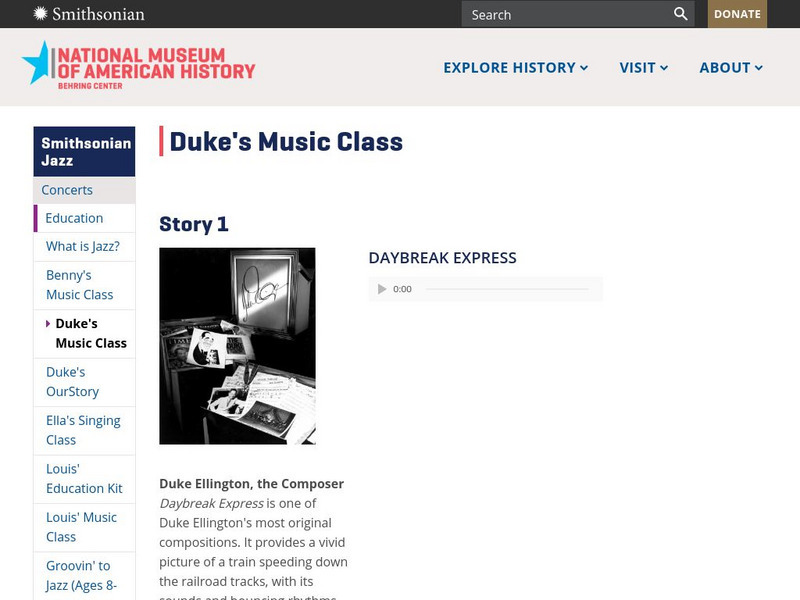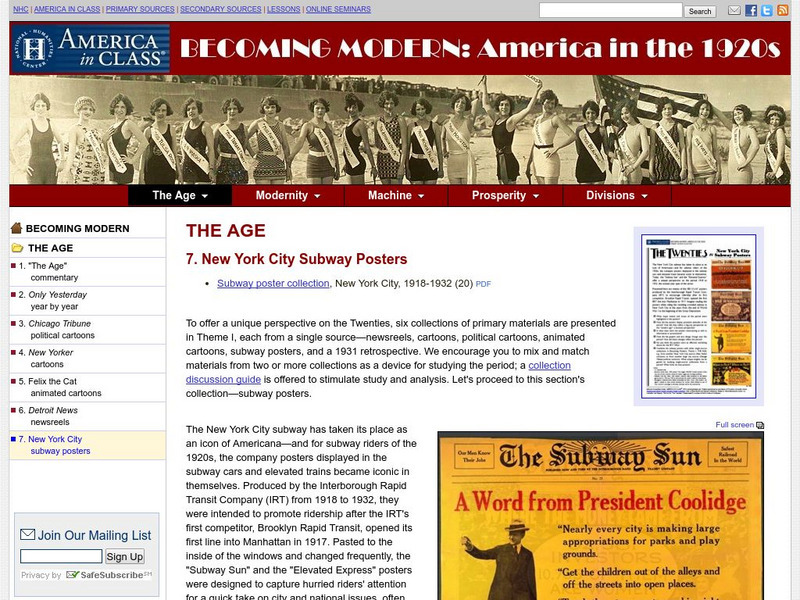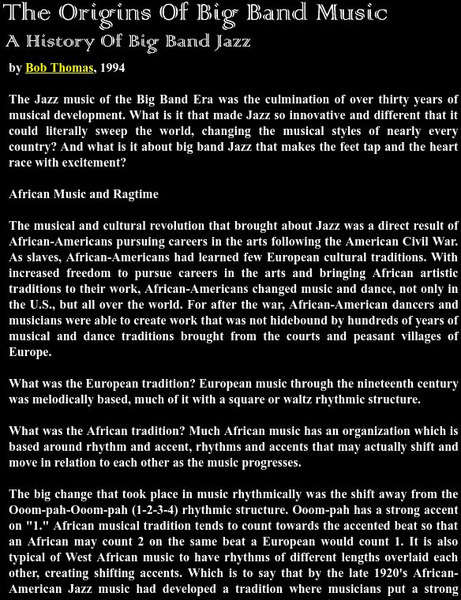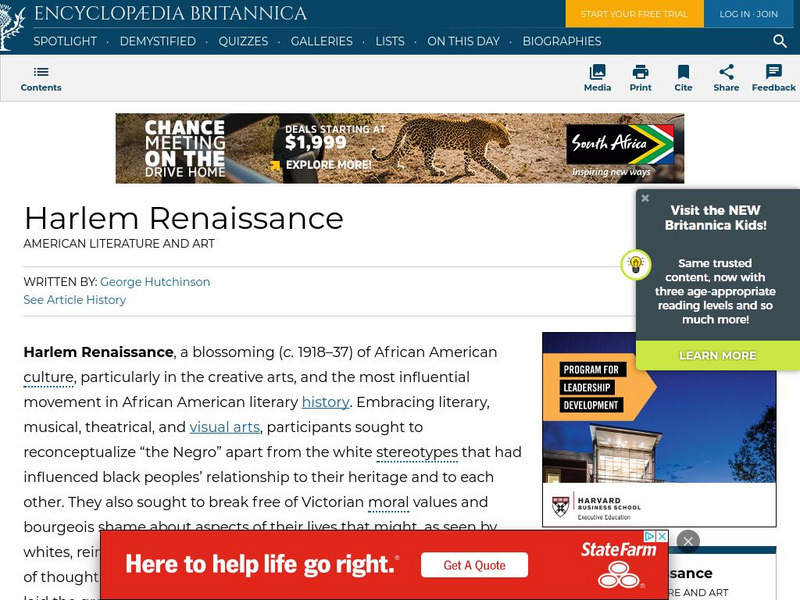Hi, what do you want to do?
Stanford University
Sulair: The Monterey Jazz Festival Collection
This fabulous site describes the repository of the digitized collection of music from the Monterey Jazz Festival from 1958 which is housed on the Stanford University campus. On this site you can read about the performances, watch and...
Other
Oculus Magazine: Early Jazz
Written for an audience accustomed to rock, this is a good history of Jazz, from the late 1800's, when the form supposedly took shape, to recommended recordings and books.
PBS
Pbs: Jazz Is About Freedom
One of the objectives in this lesson plan focus on how jazz contributed to the political awareness of the American public concerning lynching. Using Billie Holiday's anti-lynching song Strange Fruit, young scholars will learn about...
Smithsonian Institution
National Museum of American History: Smithsonian Jazz: Duke's Music Class
Learn about jazz from the master, Duke Ellington. Three activities explore his role as jazz composer, orchestra leader, and pianist.
National Humanities Center
National Humanities Center: America in Class: America in the 1920s: New York City Subway Posters
The National Humanities Center presents collections of primary resources compatible with the Common Core State Standards - historical documents, literary texts, and works of art - thematically organized with notes and discussion...
Other
Federal Focus Jazz Band: Traditional Jazz Style Guide
A stylistic breakdown and analysis of traditional jazz. Distinguishes between the different types of this unique genre.
OpenStax
Open Stax: Jazz Age 1919 1929: Prosperity and Popular Entertainment
Examines the transformation of American culture and lifestyle through movies, sports and the automobile, particularly the Model T Ford.
Curated OER
History Matters: The National Pastime in the 1920s: The Rise of the Baseball Fan
Read this article from a 1923 issue of Literary Digest that discusses the rise in interest in baseball. The author contends that the attendance at baseball games is a chance for the upper class and working class to mix socially in a way...
Scott Alexander
The Red Hot Jazz Archive: Origins of Big Band Jazz
Examines the progression from Ragtime and New Orleans jazz to Big Band.
Khan Academy
Khan Academy: American Culture in the 1920s
The First World War had a crippling effect on any notions of positivity in the artists, writers, and intellectuals of that time and they became known as the Lost Generation. This page discusses this group of people, the emergence of jazz...
Other
Nlbpa: Negro Leagues Baseball History
Find out about the history of early Negro baseball beginnings in the late 19th century before reading about the advent of the Negro National League in the 1920s. Baseball was the American pastime for everyone in the 1920s and 1930s.
Library of Congress
Loc: America's Story: u.s. Ownership of Virgin Islands
Some houses today cost the same as the Virgin Islands! Learn about the history of the U.S. Virgin Islands.
OpenStax
Open Stax: The Jazz Age: Redefining the Nation 1919 1929: A New Generation
Looks at the new morality that emerged in the 1920s. It changed the role of women and the perception of African Americans, the latter facilitated by the Harlem Renaissance and its impact on the music and dance of the Jazz Age. Also...
OpenStax
Open Stax: The Jazz Age 1919 1929: Republican Ascendancy: Politics in the 1920s
Examines the positive and negative aspects of Warren G. Harding's presidency, how Calvin Coolidge won the election of 1920, and his pro-business agenda.
Curated OER
The Red Hot Jazz Archive: A History of Jazz Before 1930
A short essay that discusses the history of jazz before 1930. Includes links to a full archive of information and recordings related to jazz.
Other
History of the Roaring Twenties
Step back in time to the 1920s and explore the history that made this era the 'Roaring Twenties'.
PBS
Pbs: Biography of Dizzy Gillespie
This PBS biography about trumpeter and jazz musician Dizzy Gillespie includes photos, multiple audio features, and links within the text to other famous musicians.
John F. Kennedy Center
The Kennedy Center: Musical Harlem
The Kennedy Center's ArtsEdge offers a great unit for introducing jazz to students. Its use of Harlem as the "glue" which binds together elements such as jazz history and jazz terminology, makes it particularly effective for the...
National Women’s History Museum
National Women's History Museum: Gertrude "Ma" Rainey
Often called the "Mother of the Blues," Ma Rainey was known for her deep-throated voice and mesmerizing stage presence that drew packed audiences and sold hit records in the early twentieth century.
Encyclopedia Britannica
Encyclopedia Britannica: Guide to Black History: Harlem Renaissance
Extensive information about the Harlem Renaissance, a period of time considered to be the cultural awakening of African Americans. Included are sections on poetry, fiction, and drama, as well as the legacy of this movement.
Department of Defense
Do Dea: Ap Us History: Unit 6: Becoming a Modern Nation
This extensive learning module examines the role of large-scale industrialization, urbanization, and mass migrations in creating new demands on government and social organizations to design reforms, and looks at the global and domestic...
National Humanities Center
National Humanities Center: America in Class: America in the 1920s: Chicago Tribune Cartoons
The National Humanities Center presents collections of primary resources compatible with the Common Core State Standards - historical documents, literary texts, and works of art - thematically organized with notes and discussion...
Pennsylvania Historical and Museum Comission
Explore Pa History: Billy Eckstine
Learn of the historical contributions of jazz musician, band leader, and Pennsylvania native, Billy Eckstine in this succinct biography.























